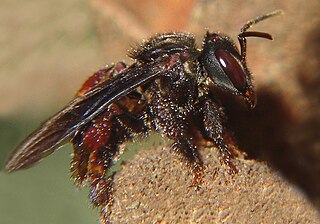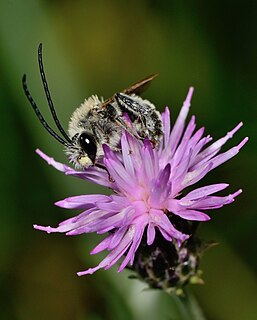
Apidae is the largest family within the superfamily Apoidea, containing at least 5700 species of bees. The family includes some of the most commonly seen bees, including bumblebees and honey bees, but also includes stingless bees, carpenter bees, orchid bees, cuckoo bees, and a number of other less widely known groups. Many are valuable pollinators in natural habitats and for agricultural crops.

Megachilidae is a cosmopolitan family of mostly solitary bees. Both that their pollen-carrying structure is restricted to the ventral surface of the abdomen, and their typically elongated labrum is characteristic of this family. Megachilid genera are most commonly known as mason bees and leafcutter bees, reflecting the materials from which they build their nest cells ; a few collect plant or animal hairs and fibers, and are called carder bees, while others use plant resins in nest construction and are correspondingly called resin bees. All species feed on nectar and pollen, but a few are kleptoparasites, feeding on pollen collected by other megachilid bees. Parasitic species do not possess scopae. The motion of Megachilidae in the reproductive structures of flowers is energetic and swimming-like; this agitation releases large amounts of pollen.

Halictidae is the second-largest family of bees with nearly 4,500 species. Halictid species are an extremely diverse group that can vary greatly in appearance. These bees occur all over the world and are found on every continent except Antarctica. Usually dark-colored and often metallic, halictids are found in various sizes, colors and patterns. Several species are all or partly green and a few are red, purple, or blue. A number of them have yellow markings, especially the males, which commonly have yellow faces, a pattern widespread among the various families of bees. The family is one of many with short tongues and is best distinguished by the arcuate basal vein found on the wing. Females in this family tend to be larger than the males.

The Eucerini are the most diverse tribe in the family Apidae, with over 32 genera worldwide that were previously classified as members of the family Anthophoridae. All species are solitary, though many nest in large aggregations, and large "sleeping" aggregations of males are found occasionally. Most genera are distinctive in the unusually long male antennae from which the tribe derives its name. They are most diverse in the Western Hemisphere.

The Stenotritidae is the smallest of all formally recognised bee families, with only 21 species in two genera, all of them restricted to Australia. Historically, they were generally considered to belong in the family Colletidae, but the stenotritids are presently considered their sister taxon, and deserving of family status. Of prime importance is that the stenotritids have unmodified mouthparts, whereas colletids are separated from all other bees by having bilobed glossae.

Andrena is a genus of bees in the family Andrenidae. With over 1,500 species, it is one of the largest genera of animals. It is a strongly monophyletic group that is difficult to split into more manageable divisions; currently, Andrena is organized into 104 subgenera. It is nearly worldwide in distribution, with the notable exceptions of Oceania and South America. Bees in this genus are commonly known as mining bees due to their ground-nesting lifestyle.

Trigona is one of the largest genera of stingless bees, comprising about 32 species, exclusively occurring in the New World, and formerly including many more subgenera than the present assemblage; many of these former subgenera have been elevated to generic status.

The Bombini are a tribe of large bristly apid bees which feed on pollen or nectar. Many species are social, forming nests of up to a few hundred individuals; other species, formerly classified as Psithyrus cuckoo bees, are brood parasites of nest-making species. The tribe contains a single living genus, Bombus, the bumblebees, and some extinct genera such as Calyptapis and Oligobombus. The tribe was described by Pierre André Latreille in 1802.

The bee subfamily Panurginae is a diverse lineage of 33 genera in 7 tribes. They are particularly diverse in the New World, though scarce in the tropics, and in the Old World they can be found primarily in the Palaearctic and Africa, but absent from Australia and tropical Asia. They tend to be associated with xeric or sandy habitats.

Eucera is a genus of bees in the family Apidae, subfamily Apinae, and tribe Eucerini – the long-horned bees.

Megachilinae is a subfamily of bees, the largest subfamily in the family Megachilidae, and includes mason bees, leafcutter bees, and carder bees.

Tetragonula is a genus of stingless bees. In 1961, Brazilian bee expert J.S. Moure first proposed the genus name Tetragonula to improve the classification system by dividing the large genus Trigona stingless bees into 9 smaller groups. About 30 stingless bee species formerly placed in the genus Trigona are now placed in the genus Tetragonula. These bees are found in Oceania, in countries such as Australia, Indonesia, New Guinea, Malaysia, Thailand, the Philippines, India, Sri Lanka, and the Solomon Islands. The most recent tabulation of species listed 31 species.

Melittidae is a small bee family, with over 200 described species in three subfamilies. The family has a limited distribution, with all described species restricted to Africa and the northern temperate zone.

Heriades is a genus of bee in the family Megachilidae. Fairly small and usually black, they are found all over the world. There are more than 130 species worldwide, roughly 25 species in North and Central America, but only 3 species are native east of the Rocky Mountains. European species such as H. truncorum can be found on the east coast of the US. Like other bees in the tribe Osmiini, Hoplitis and Ashmeadiella, they nest in cavities in wood excavated by other insects, or perhaps occasionally pine cones. They separate the cells of their nest with resin .

Anthidiini is a tribe of insects in the family Megachilidae. There are at least 40 genera and 840 described species in Anthidiini. There is strong evidence that the tribe is monophyletic.

Dianthidium is a genus of leafcutter, mason, and resin bees in the family Megachilidae. There are at least 20 described species in Dianthidium.

Stelis is a genus of kleptoparasitic bees in the family Megachilidae. There are at least 100 described species in Stelis.

Osmiini is a tribe of leafcutter, mason, and resin bees in the family Megachilidae. There are about 19 genera and at least 1,000 described species in Osmiini.
The Tarsaliini are a tribe of apine bees. They are between 7-13mm long. As of 2015, it only contains its type genus, Tarsalia, which was considered part of the tribe Ancylaini until Engel split it in 2015, he believes the Tarsaliini are more closely related to the Eucerini than the Ancylaini. An Arabian and North African tribe, the Tarsaliini have been observed in Egypt, Sudan, Iran, and the Arabian Peninsula.


















